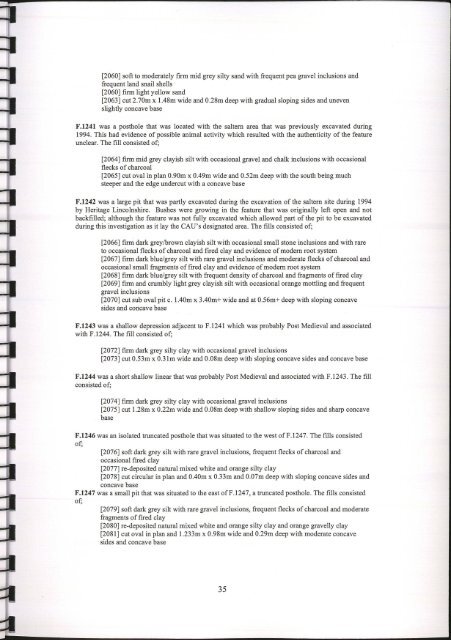Further Excavations At Langtoft. Lincolnshire www - Archaeology ...
Further Excavations At Langtoft. Lincolnshire www - Archaeology ...
Further Excavations At Langtoft. Lincolnshire www - Archaeology ...
Create successful ePaper yourself
Turn your PDF publications into a flip-book with our unique Google optimized e-Paper software.
[2060] soft to moderately firm mid grey silty sand with frequent pea gravel inclusions and<br />
frequent land snail shells<br />
[2060] firm light yellow sand<br />
[2063] cut 2.70m x 1.48m wide and 0.28m deep with gradual sloping sides and uneven<br />
slightly concave base<br />
F.1241 was a posthole that was located with the saltern area that was previously excavated during<br />
1994. This had evidence of possible animal activity which resulted with the authenticity of the feature<br />
unclear. The fill consisted of;<br />
[2064] firm mid grey clayish silt with occasional gravel and chalk inclusions with occasional<br />
flecks of charcoal<br />
[2065] cut oval in plan 0.90m x 0.49m wide and 0.52m deep with the south being much<br />
steeper and the edge undercut with a concave base<br />
F.1242 was a large pit that was partly excavated during the excavation of the saltern site during 1994<br />
by Heritage <strong>Lincolnshire</strong>. Bushes were growing in the feature that was originally left open and not<br />
backfilled; although the feature was not fully excavated which allowed part of the pit to be excavated<br />
during this investigation as it lay the CAU's designated area. The fills consisted of;<br />
[2066] firm dark grey/brown clayish silt with occasional small stone inclusions and with rare<br />
to occasional flecks of charcoal and fired clay and evidence of modern root system<br />
[2067] firm dark blue/grey silt with rare gravel inclusions and moderate flecks of charcoal and<br />
occasional small fragments of fired clay and evidence of modern root system<br />
[2068] firm dark blue/grey silt with frequent density of charcoal and fragments of fired clay<br />
[2069] firm and crumbly light grey clayish silt with occasional orange mottling and frequent<br />
gravel inclusions<br />
[2070] cut sub oval pit c. 1,40m x 3.40m+ wide and at 0.56m+ deep with sloping concave<br />
sides and concave base<br />
F.1243 was a shallow depression adjacent to F.1241 which was probably Post Medieval and associated<br />
with F.1244. The fill consisted of;<br />
[2072] firm dark grey silty clay with occasional gravel inclusions<br />
[2073] cut 0.53m x 0.31m wide and 0.08m deep with sloping concave sides and concave base<br />
F.1244 was a short shallow linear that was probably Post Medieval and associated with F.1243. The fill<br />
consisted of;<br />
[2074] firm dark grey silty clay with occasional gravel inclusions<br />
[2075] cut 1.28m x 0.22m wide and 0.08m deep with shallow sloping sides and sharp concave<br />
base<br />
F.1246 was an isolated truncated posthole that was situated to the west of F. 1247. The fills consisted<br />
of;<br />
[2076] soft dark grey silt with rare gravel inclusions, frequent flecks of charcoal and<br />
occasional fired clay<br />
[2077] re-deposited natural mixed white and orange silty clay<br />
[2078] cut circular in plan and 0.40m x 0.33m and 0.07m deep with sloping concave sides and<br />
concave base<br />
F.1247 was a small pit that was situated to the east of F. 1247, a truncated posthole. The fills consisted<br />
of;<br />
[2079] soft dark grey silt with rare gravel inclusions, frequent flecks of charcoal and moderate<br />
fragments of fired clay<br />
[2080] re-deposited natural mixed white and orange silty clay and orange gravelly clay<br />
[2081] cut oval in plan and 1.233m x 0.98m wide and 0.29m deep with moderate concave<br />
sides and concave base<br />
35

















